Monday 26 March 2012
Saturday 24 March 2012
G321: Evaluation Question 7
7) Looking back at your preliminary task, what do feel you have learnt in the progression from it to the full product?
There are many things I have learnt throughout my AS level Media Studies, from the first preliminary task and my final cut of my thriller opening. The use of certain aspects of mise-en-scene such as lighting, costume, continuity and props have all be things I have needed to consider, in order to make a successful thriller opening.
Lighting proved to be an issue whilst filming scenes for my groups thriller openings. In my preliminary task lighting, wasn't too much of an issue because of our limited understanding of cinematography. Where as in my groups thriller, lighting was very key in establishing the mood we had decided upon, whilst planning. In filming our opening my group had to switch cameras half way through because of lighting issues.
Example of bad lighting from our first recording:
This experience has made me understand how important lighting is when considering the mood and action of any genre, not just the thriller genre. My group tried a ranged of different lighting effects such as chiaroscuro lighting, low key lighting and ambient lighting, all in an attempt to create a more dramatic mood. These effects were very hard to achieve, and we decided to film in the day time, and then use lighting effects during editing, rather than wasting time trying to get the 'perfect' lighting, which would be almost impossible, without professional help or technology.
Compared to my preliminary task, my thriller opening has used a wide range of transitions to enhance the mood of the situation. In my preliminary task there are no transitions used, just quick cuts between each shot, showing how little I knew of transitions and their influence on my thriller opening.
Preliminary Task (no effects, just cuts):
Thriller Opening (range of transitions enhancing the mood of the situation):
Continuity was also an aspect of mise-en-scene me and my group had to deal with. As shown in my preliminary task evaluation and the clip, continuity was very poor, for example Jono's costume changes from him wearing a jumper to him wearing a t-shirt. Continuity also became a problem when filming my groups thriller opening. Me and my group had all of the footage that we had planned to get, and were ready to start editing. But we then got recommendations from fellow classmates, friends and our teacher, about adding in extra footage to make our thriller opening better. James had his hair cut half way through editing which didn't matter too much, as the majority of the scenes we needed to shoot did not involve James. We were quite fortunate that the recommendations only involved enigmatic figures and not James, otherwise, our thriller would not have been as dramatic as it is now.
When filming our preliminary tasks the main focus was on the use of shot-reverse-shot used in the opening of 'Pulp Fiction', and the 180 degree rule. At first myself, Jono and Nile found it quite challenging to get these simple aspects right. And looking back on it now make me think how much I have learnt over the eight months I have been taking AS level Media Studies. We were constantly told not to use mid shots during our thriller opening, as they were boring and didn't add to the mood of the situation. Therefore when filming our thriller, me and my group tried to avoid using mid shots, and instead using tilt shots, high angles and low angles, this proved to be very good advice.
There are many things I have learnt throughout my AS level Media Studies, from the first preliminary task and my final cut of my thriller opening. The use of certain aspects of mise-en-scene such as lighting, costume, continuity and props have all be things I have needed to consider, in order to make a successful thriller opening.
Lighting proved to be an issue whilst filming scenes for my groups thriller openings. In my preliminary task lighting, wasn't too much of an issue because of our limited understanding of cinematography. Where as in my groups thriller, lighting was very key in establishing the mood we had decided upon, whilst planning. In filming our opening my group had to switch cameras half way through because of lighting issues.
Example of bad lighting from our first recording:
This experience has made me understand how important lighting is when considering the mood and action of any genre, not just the thriller genre. My group tried a ranged of different lighting effects such as chiaroscuro lighting, low key lighting and ambient lighting, all in an attempt to create a more dramatic mood. These effects were very hard to achieve, and we decided to film in the day time, and then use lighting effects during editing, rather than wasting time trying to get the 'perfect' lighting, which would be almost impossible, without professional help or technology.
Compared to my preliminary task, my thriller opening has used a wide range of transitions to enhance the mood of the situation. In my preliminary task there are no transitions used, just quick cuts between each shot, showing how little I knew of transitions and their influence on my thriller opening.
Preliminary Task (no effects, just cuts):
Thriller Opening (range of transitions enhancing the mood of the situation):
Continuity was also an aspect of mise-en-scene me and my group had to deal with. As shown in my preliminary task evaluation and the clip, continuity was very poor, for example Jono's costume changes from him wearing a jumper to him wearing a t-shirt. Continuity also became a problem when filming my groups thriller opening. Me and my group had all of the footage that we had planned to get, and were ready to start editing. But we then got recommendations from fellow classmates, friends and our teacher, about adding in extra footage to make our thriller opening better. James had his hair cut half way through editing which didn't matter too much, as the majority of the scenes we needed to shoot did not involve James. We were quite fortunate that the recommendations only involved enigmatic figures and not James, otherwise, our thriller would not have been as dramatic as it is now.
When filming our preliminary tasks the main focus was on the use of shot-reverse-shot used in the opening of 'Pulp Fiction', and the 180 degree rule. At first myself, Jono and Nile found it quite challenging to get these simple aspects right. And looking back on it now make me think how much I have learnt over the eight months I have been taking AS level Media Studies. We were constantly told not to use mid shots during our thriller opening, as they were boring and didn't add to the mood of the situation. Therefore when filming our thriller, me and my group tried to avoid using mid shots, and instead using tilt shots, high angles and low angles, this proved to be very good advice.
Before filming the thriller me and my group had quite a strong understanding of what we wanted to do, and all had similar ideas. But once we started filming, we realised that some of the scenes we visualised in our minds was not do-able. This caused a lot of trouble, as we then had to think of more possible scenes to replace these ideas. We were intent on keeping with the mood we set out, and to make these scenes as dramatic as the ones before. As said in the paragraph about continuity, we had a lot of support from our fellow classmates, friends and teacher, which proved to very influential in our thriller opening. Using questionnaires such as the ones below and places of improvement from our teacher we managed to include the scenes recommended, which has truly benefited our thriller openings.
Progression of Editing my Thriller 'From the Night'
G321: Evaluation Question 6
6) What have you learnt about technologies from the process of constructing this product?
Technology is constantly changing and improving, and is an important aspects of cinematography. Before taking Media Studies for A Level, I had some knowledge of editing and the use of camera angles within cinematography, but it was very limited. I had, had previous knowledge of the program we used to edit our thriller - Adobe Premiere Elements - for videos on YouTube, but did not realise how much tools could be used to enhance and adapted video. I knew the basic 'dip to blacks' and the various transitions to choose from in the effects tab, but I didn't know exactly which transition did what. I tested out various types of effects such as additive dissolve, cross dissolve and many others, to see which effect best suited the change between each shot, and very rarely did I use the a simple cut, such as the ones shown on TV dramas. I also found out how to change the video to black and white. I decided I would go for a black and white version, just to enhance the suspense, and pay tribute to the classic noir thrillers of the 1940's, for example 'The Third Man'.
When joining the course I had little understanding of what the connotations of different angles were. For example I knew about the high angle, but didn't know it was used to show vulnerability, similarly, I knew about the low angle, but didn't know it was used to show dominance and to connote power in the character it was portrayed on. Once I had a better understanding of camera angles from research of the thriller genre, I was able to include various camera angles such as tilt shots connoting alienation, and panning and tracking shots, and come out with a much better production.
Examples of tilt shot, compared to tilt shot in 'From the Night':
Website were a big influence of my understanding of how much of an impact technology has on cinematography. During my AS level, I have learnt how to put clips from YouTube onto my blog, and how to insert screen shots into my blogs posts. In addition I also found out how to embed digital scrapbooks such as Beeclip and Prezi into my blog posts, to show my understand of the latest technologies. Furthermore, the use of websites such as Amazon.co.uk, IMDb.com and FilmSite.org allowed me to enhance a wider knowledge in both target audience and the conventions of the thriller genre.


Before the year I had very little understanding of how to use blogs, and often found myself searching the internet and advising my teachers to help me out. Now after getting this help my understanding of blogs has improved, and I am now capable of insert a wide range of analysis in different digital ways. The ability to use blogs as our foundation for our coursework, has been a very good experience, one I much prefer compared to having to write it all out on a piece of paper.

Example of posts before publishing, with a range of screen shots and videos:

Technology is constantly changing and improving, and is an important aspects of cinematography. Before taking Media Studies for A Level, I had some knowledge of editing and the use of camera angles within cinematography, but it was very limited. I had, had previous knowledge of the program we used to edit our thriller - Adobe Premiere Elements - for videos on YouTube, but did not realise how much tools could be used to enhance and adapted video. I knew the basic 'dip to blacks' and the various transitions to choose from in the effects tab, but I didn't know exactly which transition did what. I tested out various types of effects such as additive dissolve, cross dissolve and many others, to see which effect best suited the change between each shot, and very rarely did I use the a simple cut, such as the ones shown on TV dramas. I also found out how to change the video to black and white. I decided I would go for a black and white version, just to enhance the suspense, and pay tribute to the classic noir thrillers of the 1940's, for example 'The Third Man'.
When joining the course I had little understanding of what the connotations of different angles were. For example I knew about the high angle, but didn't know it was used to show vulnerability, similarly, I knew about the low angle, but didn't know it was used to show dominance and to connote power in the character it was portrayed on. Once I had a better understanding of camera angles from research of the thriller genre, I was able to include various camera angles such as tilt shots connoting alienation, and panning and tracking shots, and come out with a much better production.
Examples of tilt shot, compared to tilt shot in 'From the Night':
Website were a big influence of my understanding of how much of an impact technology has on cinematography. During my AS level, I have learnt how to put clips from YouTube onto my blog, and how to insert screen shots into my blogs posts. In addition I also found out how to embed digital scrapbooks such as Beeclip and Prezi into my blog posts, to show my understand of the latest technologies. Furthermore, the use of websites such as Amazon.co.uk, IMDb.com and FilmSite.org allowed me to enhance a wider knowledge in both target audience and the conventions of the thriller genre.


Before the year I had very little understanding of how to use blogs, and often found myself searching the internet and advising my teachers to help me out. Now after getting this help my understanding of blogs has improved, and I am now capable of insert a wide range of analysis in different digital ways. The ability to use blogs as our foundation for our coursework, has been a very good experience, one I much prefer compared to having to write it all out on a piece of paper.

Example of posts before publishing, with a range of screen shots and videos:

G321: Evaluation Question 5
5) How did you attract/address your audience?
As said in previous evaluation questions, 'Animal Kingdom' had a huge impact on the target audience we were going for. Our main priority was to attract the 16 - 25 demographic, we did this in a number of ways. First we chose a suitable location. We used a standard middle class house, similar to the one in 'Animal Kingdom', so that our target audience (16 -25 year old middle class males) could relate better to the surroundings than they would if we were to use an upper class house. Secondly we used a young male adult of similar age to our target audience as the main character, in an attempt to allow our target audience to engage in the characters situation, and feel empathy for situation. As previously said 'Animal Kingdom' was a big influence on our thriller, and helped us to develop our target audience. Therefore any audiences which enjoyed 'Animal Kingdom' may also enjoy our film as well. The use of posters in the background also helped to address our audience. Examples of popular culture are scattered around the walls of the boys bedroom. For example the popular band Paramore. Also the Joker poster not only has direct reference to popular films of Batman, but also suggests that contemporary Britain is as corrupt just like the Joker in the Batman films, and that our thriller represents this.
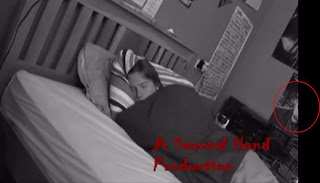
Suspense was also an important part of addressing our audience. Our thriller had to keep the viewer watching, and wanting to view the rest of the film. My group successfully accomplished this using a wide variety of camera angles, such as tilt shots and high angles, and also using quick cuts between the enigmatic figures and the characters to relate the them all together. Also the use of a gun shot immediately links to a bullet ridden body, and the audience will be wondering who's been shot. Also because our thriller is shot in the night, the gun shot is a direct reference to night-time, suggesting it is a time of death, and corruption.

Suspense was also an important part of addressing our audience. Our thriller had to keep the viewer watching, and wanting to view the rest of the film. My group successfully accomplished this using a wide variety of camera angles, such as tilt shots and high angles, and also using quick cuts between the enigmatic figures and the characters to relate the them all together. Also the use of a gun shot immediately links to a bullet ridden body, and the audience will be wondering who's been shot. Also because our thriller is shot in the night, the gun shot is a direct reference to night-time, suggesting it is a time of death, and corruption.
We decided to ask a couple of people (similar to our target audience) what they thought of our final cut. Posted below is evidence of our success.
 |
| Questionnaire Entry #1 |
 |
| Questionnaire Entry #2 |
A lot of information on this questionnaire is positive, James found the editing the better part of the film compared to anything else. He also would be inspired to see the rest of the film, and thought the soundtrack reflected the mood, all of which were me an my groups intentions, as stated below.
Kieran on the other hand thought that our strongest part of the thriller was that it was a clear opening to a thriller film. He also thought that the ending needed to be more dramatic, and the slow motions were the best feature.
Overall the responses from the questionnaires were very influential on the ending of our thriller openings, and that our thriller has conformed to me and my groups expectations of what we wanted to tap into, before filming.
Our intentions for our thriller were to create an easy to understand narrative, and to make sure none of the scenes were confusing. Also the soundtrack had to directly link to the thriller opening and reflect the current mood. Furthermore, our thriller had to show clear signs of an opening to thriller, rather than just a random scene within a thriller. All of these points were successfully achieve when considering the feedback we had received. After taking on board advice from our teacher and our questionnaire responses I decided to change the ending to making it much more dramatic. The original ending was a still shot of the enigmatic figure in the window, with the title over the top. But after the feedback I decided to change it, and now it's ends with the boy running in front of a cars headlights, and a quick cut to an enigmatic figure waiting in the car. I feel that this was much better ending than before, and the use of slow motion added to the suspense and cliff hanger of the thriller opening. The cliff hanger leaves the audience wondering what is going to happen to the boy, who the enigmatic figures were, and why was the mother shot. To those familiar with the thriller genre, our dark, meaningful mise-en-scene could suggest corruption, and that the happenings are all effecting the boy, as if he is trapped, leaving the audience intrigued about what could happen next.
Wednesday 21 March 2012
G321: Evaluation Question 4
4) Who would be the audience for your media product?
The main target audience for our thriller 'From the Night' is between the 16 - 25 year old bracket, mainly males of middle class stature. The prezi below shows a collage of our target audience, and what their interests or hobbies may be.
As shown on the collage, our target audience may be interested in certain aspects of popular culture such as the rock magazine Kerrang and the TV show Skins. They may also enjoy watching comedic panel shows such as Mock the Week and Never Mind the Buzzcocks, and may be interested in shows such as The Inbetweeners and Dr. Who.
Our thriller is trying to target the of 16 - 25 year old demographic, this is mainly because the main character in the film is of a similar age, therefore the audience is more likely to engage with his situation. Some of films I have researched that have a young main character, are more popular with the younger audience, for example, in 'Animal Kingdom' 'J' is young adult between the age of 16 - 25, so people of a similar age rated the film the highest out of all the demographics. This also evident in 'Essex Boys'.
The location can also play a part in establishing our target audience. For example in our thriller the location is a standard middle class house, which could appeal to a more middle class audience, as they could find the surroundings much more familiar, compared to an upper class house.
The main target audience for our thriller 'From the Night' is between the 16 - 25 year old bracket, mainly males of middle class stature. The prezi below shows a collage of our target audience, and what their interests or hobbies may be.
As shown on the collage, our target audience may be interested in certain aspects of popular culture such as the rock magazine Kerrang and the TV show Skins. They may also enjoy watching comedic panel shows such as Mock the Week and Never Mind the Buzzcocks, and may be interested in shows such as The Inbetweeners and Dr. Who.
Our thriller is trying to target the of 16 - 25 year old demographic, this is mainly because the main character in the film is of a similar age, therefore the audience is more likely to engage with his situation. Some of films I have researched that have a young main character, are more popular with the younger audience, for example, in 'Animal Kingdom' 'J' is young adult between the age of 16 - 25, so people of a similar age rated the film the highest out of all the demographics. This also evident in 'Essex Boys'.
 |
| Animal Kingdom Demographics |
 |
| Essex Boys Demographics |
The use of a male main character could suggest that our thriller may appeal more to males, rather than females, examples of this are 'Animal Kingdom', where males under 18 rated the film 7.6, whereas females under 18 rated the film 7.4. It could be argued that females may enjoy our film more the only female character is seen dead, therefore the female audience could be interested by the mother's situation, and decide to watch more of the film, to try and find out what got the mother killed in the first place. In 'Essex Boys' the majority of the characters are males between the ages of 16 and 25. But as shown in the demographics, the film was much more popular with the female audience. Females aged 18 - 29 rated the film 7.1, compared to males aged 18 - 29 rated the film only 6.0. As the film develops Jason's girlfriend Lisa begins to take control of the situation, this could be a reason why the female audience have rated this film higher than the male audience.
Tuesday 20 March 2012
G321: Evaluation Question 3
3) What kind of media institution might distribute your media product and why?
My group’s thriller would better appeal to a media institution like Warp Films rather than Working Title, for a number of different reasons. 'From the Night' is mainly focused on the life of a troubled young man, who has had to deal with violence and a society of intrigue. This could be linked to the film 'This is England' where the audience follows the troubled lives of the young men and women. My group’s thriller is an independent film, with a low budget production, therefore may be suited to a media institution such as Warp films. Warp films tend to take on more independent films and the general market is the 16 – 20 year old demographic, examples of this are, 'Animal Kingdom' and 'Snowtown'. In both of these films it is evident that they are directed towards the younger generation, for example in Animal Kingdom the main character – Josh– relates to an audience similar to his age. As shown in the demographics below, the film was most popular with males under 18, this is because Josh is of a similar age, and therefore the audience can engage and feel empathy for his situation.
My group’s thriller would better appeal to a media institution like Warp Films rather than Working Title, for a number of different reasons. 'From the Night' is mainly focused on the life of a troubled young man, who has had to deal with violence and a society of intrigue. This could be linked to the film 'This is England' where the audience follows the troubled lives of the young men and women. My group’s thriller is an independent film, with a low budget production, therefore may be suited to a media institution such as Warp films. Warp films tend to take on more independent films and the general market is the 16 – 20 year old demographic, examples of this are, 'Animal Kingdom' and 'Snowtown'. In both of these films it is evident that they are directed towards the younger generation, for example in Animal Kingdom the main character – Josh– relates to an audience similar to his age. As shown in the demographics below, the film was most popular with males under 18, this is because Josh is of a similar age, and therefore the audience can engage and feel empathy for his situation.
 |
| *Animal Kingdom demographics* |
 |
| *Warp Films website* |
 |
| *Working Title website* |
Compared to Working Title, Warp’s website has a much more user friendly feel, displaying popular films such as 'Snowtown' as their main attraction. The Working Title website looks a lot more professional, which could suggest their films are more mainstream than Warp’s. Our thriller is not mainstream, like 'Tinker Tailor Soldier Spy', it is a low budget independent film, like 'Animal Kingdom', so we would be better suited to use Warp as our distributor. Also Working Title target a much older demographic (under 40s), for example films such as ‘Tinker Tailor Soldier Spy’ and ‘Contraband’, who have slightly older actors and actresses.



Like ‘Animal Kingdom’, it would be best to use social networking sites as are our main focus for marketing, rather than using adverts, after all our film is low budget, and may be swamped by other more mainstream films, such as ‘Tinker Tailor Soldier Spy’. Also the less money we spend to adverts, the better production our film will be. The success of using social networking sites such as Facebook and Twitter is evident in ‘Animal Kingdom’. Working Title used Facebook and Twitter to advertise ‘Animal Kingdom’, it was one of the most hotly anticipated local releases of the year 2010, and won the award World Cinema Jury Prize at the Sundance Film Festival in 2010. My group’s thriller is mainly focused on the aspects of production, distribution and marketing used by Working Title on ‘Animal Kingdom’, therefore advertising on social networking sites will be more beneficial.
If there was an option to release the film in cinema’s, then companies such as Picture House may be interested in distributing our film. Using Picture House as a distributor could have a major affect on the marketing strategy. Picture House tend to advertise using leaflets and brochures. Over 2.5 million brochures were printed and distributed in cinema's within their chain. They also have a national magazine, in which our film could be advertised. Picture House are also the leading independent cinema operator in the UK
It could be possible to coincide with a rental company, such as LOVEFiLM. LOVEFiLM were brought out by Amazon, and now stream content with Disney, Warner Bros. and Lionsgate. This could become very beneficial, as our film could be advertised on Amazon's website. LOVEFiLM also signed a deal with StudioCanal (a Europe based company) who help fund 'Tinker Tailor Soldier Spy'. The deal allowed StudioCanal titles to be made available to LOVEFiLM members as part of their membership, this would further advertise our film. Also LOVEFiLM have connections with the gaming console XBOX 360, and by signing with LOVEFiLM we could potentially stream content to people with this gaming console, in their own home, therefore widening our audience and further advertising it to the public.
Sunday 18 March 2012
Kill Bill Vol 2 (Burial Scene)
Kill Bill vol. 2 was produced by Quetin Tarantino in 2004, starring Uma Thurman and David Carradine. This scene is a fantastic example of the use of claustrophobic spaces in thriller films. The bride has just been captured by Bill's brother Budd, and is put in a coffin and buried alive.The coffin is very claustrophobic in itself, but also the dirt around the coffin could act as a second barrier entrapping the bride twice, preventing her from getting out. The claustrophobic space gives sense of entrapment and suggests that there is no way out for the bride. Claustrophobic spaces used in many thriller films such as 'The Third Man' and 'Buried', both of these films also show excellent examples of the use of claustrophobic spaces.
The non-diegetic soundtrack by Ennio Morricone is incredibly significant in engaging the audience with the bride. The soundtrack creates a sense of ambition, and the audience can't help but feel spurred on by it, and want the bride to get out of the coffin. This soundtrack is also used in the film called 'The Good the Bad and the Ugly' produced by Sergio Leone in 1966. By using this soundtrack Tarantino may be paying direct tribute to Sergio Leone's film.
The uses of chiaroscuro lighting used in this scene helps to highlight areas of darkness and light. This lighting gives off a very natural feel, which helps add to the realism of the scene. Examples of chiaroscuro lighting are also used in the film 'Buried'.
'The Third Man' Sewer Scene Analysis
This analysis starts from 2:00 through to the end of the video.
It starts with a mid shot, which establishes the surroundings, and shows that Lime is in a hurry to shake off the authorities after him. The location of the sewer is perfect, it could suggest that this is were Lime deserves to be, and could be seen as a sewer rat. The high angle of the authorities places them further up the frame, which could suggest they have the power, and authority over Lime. The quick cut backs to the establishing shot suggest that the authorities trying to catch Lime and will even delve into the smelly sewers to get him.
 This shot is an example of a vanishing point shot with a tilt shot. 'The Third Man' is incredibly famous for the tilt shots used in it, and this shot is a fantastic example. The vanishing point acts as the point of danger, it shows that Lime is potentially running into danger. Also the tilt shot (A.K.A Dutch Angle) creates a sense of mystery and could suggest the alienation of Lime within society. This shot is then used again at 2:16, to reinforce his alienation from society. The vanishing shots could have intertextuality with the shots used in 'Essex Boys', when Billy and Jason are driving towards the vanishing pint, and in 'Witness' when Samuel (the boy) is walking towards the vanishing point.
This shot is an example of a vanishing point shot with a tilt shot. 'The Third Man' is incredibly famous for the tilt shots used in it, and this shot is a fantastic example. The vanishing point acts as the point of danger, it shows that Lime is potentially running into danger. Also the tilt shot (A.K.A Dutch Angle) creates a sense of mystery and could suggest the alienation of Lime within society. This shot is then used again at 2:16, to reinforce his alienation from society. The vanishing shots could have intertextuality with the shots used in 'Essex Boys', when Billy and Jason are driving towards the vanishing pint, and in 'Witness' when Samuel (the boy) is walking towards the vanishing point.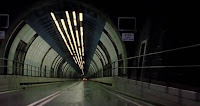
The constant cuts between Lime position and Martins position link the two characters together, and suggest that Martins is out to get answers from Lime. There are also quick cuts between Lime's position and the authorities, showing that they too are after Lime, and will try anything they can to get him.
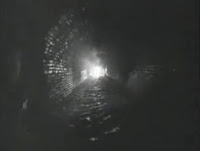 As Lime tries to escape he comes across some of the authorities. This shot again is an brilliant example of a vanishing shot, as said before this shot represents danger, therefore the authorities are the danger. This could be complete contrast. Lime is seen as the threat throughout the majority of the film, the roles are now reversed and Lime is no longer the threat, the authorities are, this completely reserves the role of Harry Lime in 'The Third Man'.
As Lime tries to escape he comes across some of the authorities. This shot again is an brilliant example of a vanishing shot, as said before this shot represents danger, therefore the authorities are the danger. This could be complete contrast. Lime is seen as the threat throughout the majority of the film, the roles are now reversed and Lime is no longer the threat, the authorities are, this completely reserves the role of Harry Lime in 'The Third Man'. 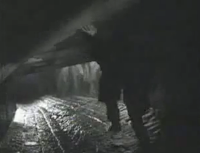 As more and more authorities enter the Lime is increasingly getting tired. As the authorities enter the sewer, there are a lot of shots of Lime in claustrophobic spaces. The Claustrophobic shots could suggest that Lime is trapped and has no way of getting, but could also reinforce the fact that he is seen as a sewer rat. This shot also has intertextuality with 'Kill Bill vol 2' Burial Scene, where the bride is trapped in the coffin and it seems to not be able to get out.
As more and more authorities enter the Lime is increasingly getting tired. As the authorities enter the sewer, there are a lot of shots of Lime in claustrophobic spaces. The Claustrophobic shots could suggest that Lime is trapped and has no way of getting, but could also reinforce the fact that he is seen as a sewer rat. This shot also has intertextuality with 'Kill Bill vol 2' Burial Scene, where the bride is trapped in the coffin and it seems to not be able to get out.  |
| Claustrophobic space in Kill Bill Vol. 2 |
This is one of the most iconic shots in the whole scene. It fuses a vanishing shot, with the claustrophobic spacing, whilst also silhouetting Lime. Lime is moving towards the vanishing point, which represents danger, and the claustrophobic space helps to reinforce the idea of Lime being trapped.
The constant quick cuts between the holes in the middle of the sewer suggest that Lime is surrounded and there is no way out form, they have got him. Eventually Martins manages to find but not before Lime shoots one of the authorities. Lime gets shot, and starts crawling up the stairs. This shows the sheer desperation of Lime, and the fact that he feels he can escape even though he got shot. The high angle of Lime connotes a drop in power and authority, ultimately it shows Lime as vulnerable and powerless.
The vanishing shot of Martins very significant. Normally vanishing shots are used to emphasise the danger within the central point, whereas in this case Martins is the danger going towards Lime, the roles are yet again reversed.
After all of the chasing and running, Martins eventually kills Lime, but doesn't get an answer to why he Lime did what he did.
How Carol Reed Establishes Genre in 'The Third Man'
 'The Third Man' directed by Carol Reed was produced in 1949 based on a novel by Graham Greene, starring Orson Welles, Joseph Cotten and Alida Valli. As the opening credits roll, there is a very distinct diegetic soundtrack of the Zither played by Anton Karas. This soundtrack is now widely associated with this classic noir thriller. 'The Third Man Theme' as it is known as, topped the international music charts in 1950. The zither is most commonly found in Slovenia, Austria, Hungary and southern regions of Germany. Before the film even starts the zither acts as a cultural signifier, which is significant because the film is set in Vienna, Austria.
'The Third Man' directed by Carol Reed was produced in 1949 based on a novel by Graham Greene, starring Orson Welles, Joseph Cotten and Alida Valli. As the opening credits roll, there is a very distinct diegetic soundtrack of the Zither played by Anton Karas. This soundtrack is now widely associated with this classic noir thriller. 'The Third Man Theme' as it is known as, topped the international music charts in 1950. The zither is most commonly found in Slovenia, Austria, Hungary and southern regions of Germany. Before the film even starts the zither acts as a cultural signifier, which is significant because the film is set in Vienna, Austria.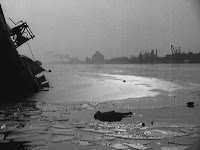
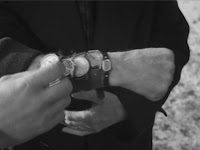 Once the opening credits pass, there are quick cuts between landmarks of Vienna, which are also act as a cultural signifier, reinforcing the fact that the film is set in Vienna. After the landmarks are passed it cuts to a low angle close of a couple of shifty characters. The close up of the goods shows the watches, obviously being sold illegally possibly on the black market. This could suggest that the society of Vienna is corrupt, and that criminals are roaming free, and crime is not being dealt with. It then cuts to an establishing shot of the shoreline of Vienna. As the establishing shot passes the audience see the fractured ice towards to abandoned and derelict ship. The fractures within the ice could suggest Vienna is a fractured society, which is ironic considering that World War II ended just 4 years before.
Once the opening credits pass, there are quick cuts between landmarks of Vienna, which are also act as a cultural signifier, reinforcing the fact that the film is set in Vienna. After the landmarks are passed it cuts to a low angle close of a couple of shifty characters. The close up of the goods shows the watches, obviously being sold illegally possibly on the black market. This could suggest that the society of Vienna is corrupt, and that criminals are roaming free, and crime is not being dealt with. It then cuts to an establishing shot of the shoreline of Vienna. As the establishing shot passes the audience see the fractured ice towards to abandoned and derelict ship. The fractures within the ice could suggest Vienna is a fractured society, which is ironic considering that World War II ended just 4 years before.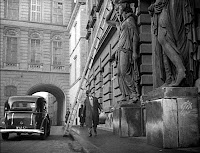 The quick cut reveals an Holly Martins (on of the main characters) in a trilby hat and overcoat. The trilby hat is a classic feature of noir thrillers of the 40's and 50's, and had become the dress code of the 1940's period when the classic noir thriller was at it's finest. The shot of Martins walking under the ladder is a very common superstition. This could suggest the Martins is quite unlucky, and that as the film progresses Martins becomes more and more unlucky.
The quick cut reveals an Holly Martins (on of the main characters) in a trilby hat and overcoat. The trilby hat is a classic feature of noir thrillers of the 40's and 50's, and had become the dress code of the 1940's period when the classic noir thriller was at it's finest. The shot of Martins walking under the ladder is a very common superstition. This could suggest the Martins is quite unlucky, and that as the film progresses Martins becomes more and more unlucky.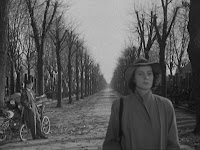
Many films such as Essex Boys show the character going towards the vanishing point, Reed therefore challenges this convention and decides to reverse it. Anna is going away form the vanishing and could suggest that she has just come out of the danger, or she has come out of a different world, which could show she isn’t actually what Martins thinks she is, she is unknown.
Title Sequence: How Jackie Brown is Established
‘Jackie Brown’ directed by Quentin Tarantino, was produced in 1997, starring Pam Grier, Samuel L. Jackson and Robert De Niro. The majority of this clip, is a constant tracking shot of Jackie Brown (the main character) walking through the airport terminal, and into her work place. This is one of the longest tracking shots in film history. This lengthy shot not only establishes the setting in which this scene is taking place, but also could outline the importance of this character. The body language of Jackie is very important in establishing her as a main character of the film. She seems quite calm and her posture could suggest she has authority. Also the camera angle is a slight low angle medium shot, which places Jackie further up the screen suggesting dominance and power. The non-diegetic soundtrack playing in the background is Across 110th Street by Bobby Womack. After researching the song I realised that the lyrics were about the hardship of street life. Further on in the film it becomes clear that this song has a direct link to the film, as seen in the shooting of Beaumont
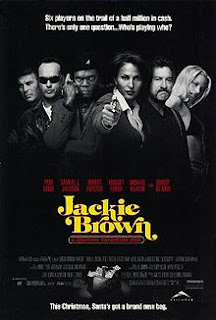 After Jackie steps off of the moving walkway it cuts to yet another panning shot, this time it’s a much lower angle than before. As previously said a low angle places the character further up the screen connoting dominance and authority. In this case the camera is much lower than before, which could suggest she is above the civilians in the social hierarchy, and has a bigger influence on society compared to the role of the civilians.
After Jackie steps off of the moving walkway it cuts to yet another panning shot, this time it’s a much lower angle than before. As previously said a low angle places the character further up the screen connoting dominance and authority. In this case the camera is much lower than before, which could suggest she is above the civilians in the social hierarchy, and has a bigger influence on society compared to the role of the civilians.The sole focus is on Jackie, the blurred out background could suggest the civilians are blurred out of society and that on one person matters, at that’s Jackie. The slight low angle shot at 2:36 shows Jackie walking passed all of the civilians. This could suggest that Jackie is ahead of everybody in society, and that she has the drive to become further ahead.
Subscribe to:
Posts (Atom)




.jpg)



.jpg)
.jpg)
.jpg)












